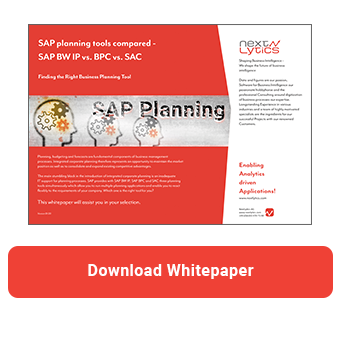The German SAP User Group Conference (DSAG) is over and there was a lot of interesting information in the field of data and analytics. In this article, we summarise the most important points from the numerous keynotes and presentations.
Seamless planning with SAC and Datasphere
One major topic was the integration of SAP Analytics Cloud (SAC) models in SAP Datasphere. The data planned in SAC is saved directly in SAP Datasphere and is available for further processing. Instead of having to reload the data from SAC to SAP Datasphere, planned values can be used together with the actuals in various views and shared with other spaces. This is an important step that makes integrated planning easier, as the endless back and forth with the data is tedious.
Modelling will continue to take place in SAC. It will be possible to decide whether dimensions and models are saved as usual in SAC or in SAP Datasphere. In future, SAC Multiactions will not only be able to trigger tasks within SAC, but also execute tasks in Datasphere, such as triggering data flows.

While SAP Analytics Cloud data actions can already be used to map a wide range of customised planning logics, integration with Datasphere opens up new possibilities. For example, developers can decide whether complex logics are better implemented in SAC (e.g. using data actions) or in Datasphere (e.g. using SQL or Python-based logics). It is important to emphasise that the core of the planning remains in SAC. The aim is therefore not to replace existing data actions, but to create new process-related integration options. One application example would be an automated forecast in Python with machine learning APIs. All of this happens without having to switch the planning model between a load and a planning mode, as it was the case in SAP BW.
In addition to the functions announced for the controlled release, the question therefore arises as to how seamless planning not only optimises the replication-free data integration of actual data, master data and data from other planning models, but also creates new opportunities to optimise complex planning processes.
However, there are also some limitations in the first release. For example, the SAC objects in SAP Datasphere are write-protected and cannot be filled via data flows in SAP Datasphere. This means that while the data from SAC is no longer loaded back into Datasphere, the SAC models must still be supplied via SAC import processes.
These and other minor restrictions will be fixed in future updates. We are looking forward to it. After five years, it's finally time for the two cloud products to be integrated. This will greatly simplify collaboration across different business areas, which has always been the promise of SAP Datasphere. This brings us closer to true advanced planning and analysis (xP&A).
SAP Planning Tools Compared -
Download the Whitepaper here!
SAP Analytics Cloud Strategy and Roadmap
In addition to the presentation of seamless planning, SAP also gave an outlook on the future of SAC. Integration into the SAP landscape, planning, composable analytics, live connection options, improvements to the data analyser, simplicity, scalability, integration with MS Office and generative AI were named as strategic priorities.
As already indicated with seamless planning, SAP Analytics Cloud is to be integrated even more closely into SAP Datasphere, Business Technology Platform (BTP) and other SAP industry applications. On the other hand, SAC will benefit from better integration with Microsoft products such as Excel, PowerPoint and Outlook. As Analysis for Office cannot work with the new SAC models, the SAC Excel add-in urgently needs to be improved. Recently, SAP has also published a PowerPoint add-in.

The Data Analyser is to be improved with new functions and integration into story workflows and JustAsk. And speaking of JustAsk, AI components are to be added to all SAC workflows in the long term. Moreover, live connections will also support third-party SQL sources. Initially, the live connection to Google Big Query will be enabled. Further external data sources are to follow. This eliminates the need to physically replicate data lakes in SAC.

In the context of planning, SAP Analytics Cloud Compass was introduced. This tool allows users to carry out scenario simulations based on the Monte Carlo method. The user-friendly interface makes it possible to simulate uncertainties in critical influencing factors and see the probable effects. An example would be the simulation of the impact of the inflation rate in the range of 2% to 4% on the annual net profit.
Alongside AI, composable analytics is another future trend. This involves a flexible approach to data analysis in which various analytical modules, tools and services can be combined like building blocks. This allows customised solutions to be created that are tailored to specific user needs. In this context, SAP is presenting an API for the integration of SAC widgets. For example, charts or tables can be displayed in different front ends, such as MS Office products, SAP Business Apps or even external apps.

In addition, the presentation mode will be further improved. This extends the Unified Stories with Digital Boardroom functions. Content from different stories can be imported and displayed in a uniform presentation. There are also extensive setting options for configuring the functions across all stories.

Finally, the new Performance Insight Tool was also presented. It provides extensive statistics for recognising components and scripts with long runtimes. Furthermore, suggestions on what can be improved in the respective story are provided.
Bonprix's journey to SAP Datasphere
As usual at DSAG, customers also presented interesting contributions alongside SAP itself. Bonprix, for example, provided insights into their journey from SAP BW 7.5 to BW/4HANA and SAP Datasphere. It is worth noting that Bonprix has opted for parallel operation of BW/4HANA and Datasphere. Datasphere is to be used primarily for self-service by giving SQL Access to BW data models in the hands of the users. Access from Datasphere to BW/4HANA is completely virtual.
However, new use cases with replication of BW data to Datasphere are also being considered. In future, the BW share will likely be reduced and the Datasphere share increased.
It was interesting to learn that Bonprix has set itself the goal of using hardly any ABAP in the BW/4HANA migration and implementing everything in SQL wherever possible. From our point of view, this is consistent and correct, among other things to create a solid basis for (partial) migrations of the data models from BW to Datasphere.

Partnership SAP & STACKIT
A strategic partnership between SAP and the German cloud provider STACKIT was also announced at DSAG. STACKIT will provide the basis infrastructure to distribute SAP products via the RISE programme.
It is worth mentioning that NextLytics is already a service partner of STACKIT. We are in intensive dialogue to deepen this cooperation. Also with regard to our NextTables solution for simple data processing and import into SAP systems. The new NextTables release could be hosted as a SaaS product on STACKIT and offered as a one-click product. More information will follow shortly.

German SAP User Group Conference 2024 Data and Analytics - Our Summary
Overall, the DSAG Congress was an all-round successful event at which many innovations were presented and new friendships were forged. We had many interesting discussions at our stand and would be delighted to welcome you again next year.
Would you like to find out more about NextTables? We would be happy to present the current version of NextTables to you in detail and show you all the possible applications in our feature gallery.
SAP Analytics Cloud, SAP Planning, SAP Data Warehouse, Datasphere


























